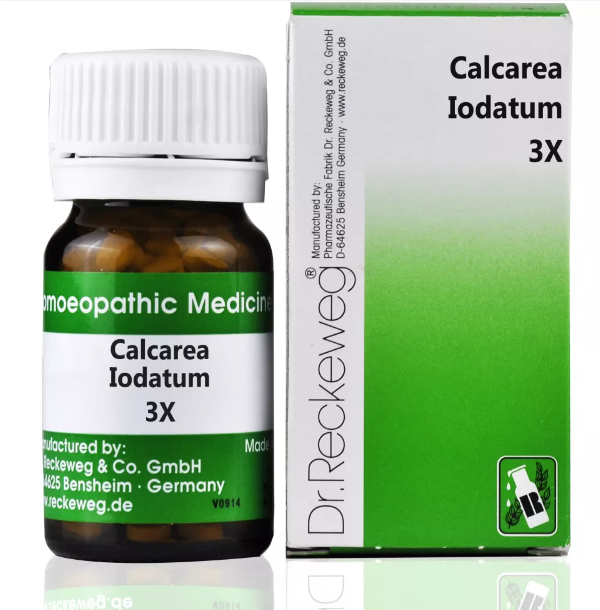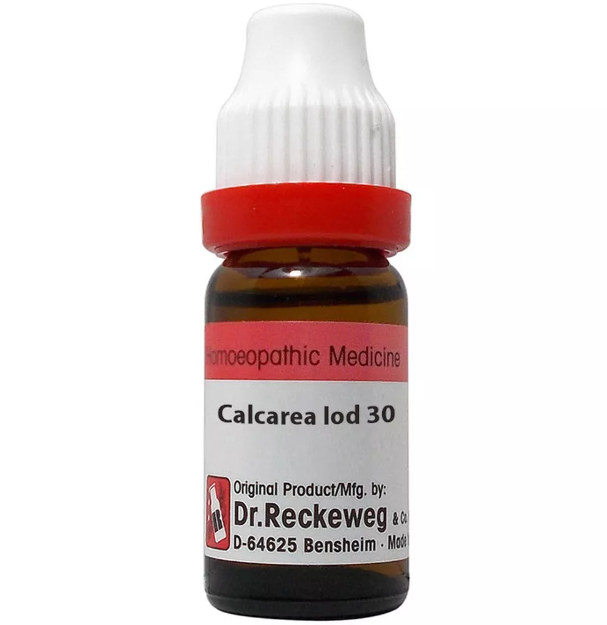CALCAREA IODATA 3x, 6x, 6C, 12C, 30C, 200C, 1M, 10M USES AND SYMPTOMS
 Calcarea Iodata (Iodide of Lime), known as Calc-i, is effective in treating scrofulous conditions, particularly enlarged glands and tonsils. It proves beneficial for thyroid enlargements around puberty, especially in flabby children prone to colds. This remedy addresses profuse, yellow secretions and adenoids, along with uterine fibroids and croup.
Calcarea Iodata (Iodide of Lime), known as Calc-i, is effective in treating scrofulous conditions, particularly enlarged glands and tonsils. It proves beneficial for thyroid enlargements around puberty, especially in flabby children prone to colds. This remedy addresses profuse, yellow secretions and adenoids, along with uterine fibroids and croup.
Head: Headache exacerbated by cold wind; sensation of lightheadedness.
Nose: Catarrh, worse at nasal root; frequent sneezing with diminished sensation; polyps in nose and ear.
Throat: Enlarged tonsils with filled crypts (follicular tonsillitis).
Respiratory: Chronic cough; chest pain and breathing difficulty post-syphilis or mercury exposure; hectic fever with green, purulent expectoration; croup; pneumonia.
Skin: Indolent ulcers with varicose veins; excessive perspiration; copper-colored, papulous eruptions, including tinea, favus, and crusta lactea; glandular swelling (Hodgkin’s disease); cracked skin and hair loss.
Relationship: Agraphis nutans (Bluebell) for adenoids with enlarged tonsils; Sulphur-iodatum follows both Agraphis and Calcarea Iodata; Aconitum lycoctonum for glandular swelling and Hodgkin’s disease. Also compare with Calcarea fluorica, Silicea, and Mercurius iodatus flavus.
Dose:Second and third trituration.
SYMPTOMS OF CALCAREA IODATA
Head:
Headache worsened by riding against cold wind.
Feeling lightheaded.
Nose:
Catarrh, particularly worse at the root of the nose.
Sneezing with reduced sensation.
Presence of polyps in the nose and ear.
Throat:
Enlarged tonsils with filled crypts, indicating follicular tonsillitis.
Respiratory:
Chronic cough.
Chest pain and difficulty in breathing following syphilis or mercury exposure.
Hectic fever with green, purulent expectoration.
Conditions like croup and pneumonia.
Skin:
Indolent ulcers accompanying varicose veins.
Excessive perspiration.
Copper-colored, papulous eruptions such as tinea, favus, and crusta lactea.
Swelling of the glands, possibly indicating Hodgkin’s disease.
Cracked skin and hair loss.
selection of the potency
Individualization:
- Homeopathy is based on the principle of treating the individual, not just the disease. The unique symptoms and characteristics of the person are crucial in determining the most suitable potency.
Intensity of Symptoms:
- The intensity of the symptoms guides the choice of potency. If the symptoms are intense and acute, a lower potency (e.g., 6C, 30C) might be considered. For chronic conditions with less intensity, higher potencies (e.g., 200C, 1M) may be appropriate.
Sensitivity of the Patient:
- Some individuals are more sensitive to homeopathic remedies, while others may require higher potencies. The practitioner considers the patient’s sensitivity when selecting the potency.
Acute vs. Chronic Conditions:
- Lower potencies are often used for acute conditions, while higher potencies may be considered for chronic or long-standing issues.
Previous Response to Potencies:
- The patient’s response to previous homeopathic treatments helps guide the choice of potency. If a particular potency has been effective in the past, it may be repeated or adjusted as needed.
Vital Force and Susceptibility:
- Homeopathy views illness as a disturbance in the vital force. The practitioner assesses the patient’s overall vitality and susceptibility to determine the appropriate potency.
Aggravation or Amelioration:
- The direction of the symptom response (aggravation or amelioration) after taking a remedy can influence the choice of potency.
Miasmatic Considerations:
- In classical homeopathy, the concept of miasms (inherited disease tendencies) is considered. The practitioner take this into account when selecting the potency.
Practitioner Experience:
- The experience and preference of the homeopathic practitioner play a role. Some practitioners may have success with certain potencies based on their clinical experience.
SAFETY INFORMATION
- Do not exceed the recommended dose by physician
- Keep out of the reach of children
- Store in a cool dry place away from direct sunlight
- Maintain half an hour gap between food/drink/any other medicines and homoeopathic medicine
- Avoid any strong smell in the mouth while taking medicine e.g. camphor, garlic, onion, coffee, hing
Medicine images use for reference only selection of homeopathic medicine depends on the individual’s specific symptoms and overall constitution. Moreover, homeopathy is a holistic system of medicine that treats the individual as a whole. In addition to addressing the physical symptoms, it takes into account the emotional and mental state of the person. Consequently, it’s crucial to consult with a qualified homeopathic practitioner for personalized treatment.
The information provided on this website is intended solely for educational purposes. Always seek the advice of your physician or other qualified health provider.
